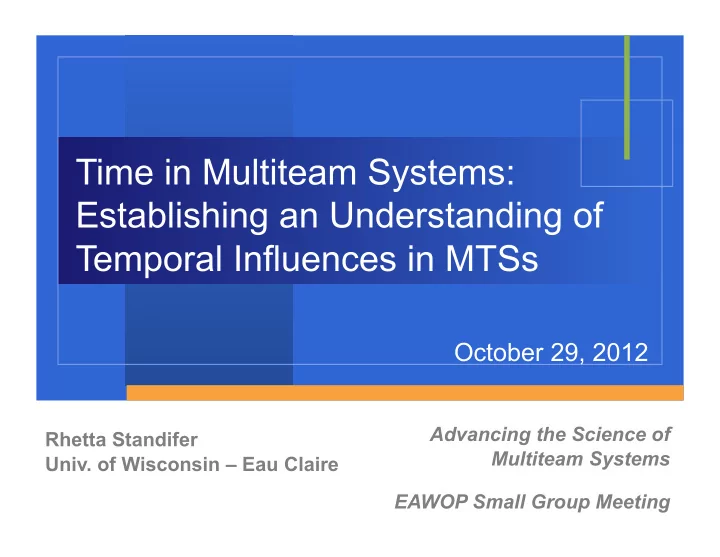

Time in Multiteam Systems: Establishing an Understanding of Temporal Influences in MTSs October 29, 2012 Advancing the Science of Rhetta Standifer Multiteam Systems Univ. of Wisconsin – Eau Claire EAWOP Small Group Meeting
Temporal Aspects of MTSs Temporal Coordination Entrainment Temporal Context (and pauses) Temporal Portfolios Temporal Perspectives Shared Temporal Understanding Temporal Leadership Temporal Conflict
ENTRAINMENT ¡
Entrainment Interconnected rhythmic activity Cycle Pace Episodes Dominant Rhythms “temporal” and “phase” entrainment
Entrainment Dominant Rhythm Cycle Pace
TEMPORAL ¡CONTEXT ¡
Example: America’s Cup Cross-Boundary MTS America’s Cup Management Team Team Team Oracle Mascalzone Alinghi
Example: America’s Cup Internal MTS Team Team Alinghi Oracle Building Sailing Design Team Team Team
Temporal Context Framework of categories similar episodic activities Benefits: improved coordination, goal completion adaptation & flexibility identify routines & pauses Deductive and inductive MTS leadership: macro to specific Subteam leadership: specific to macro
Temporal Context MTS Leaders Step 1: primary rhythmic cycles, dominant rhythms, distal goals Step 2: characteristics of dominant rhythms key internal/external stakeholders Step 3: expectations of subteam outcomes Step 4: system-level routines (sets of activities completed together)
Temporal Context Subteam Leaders Step 4: categorizations of similar types of episodic activity Step 3: temporal characteristics of these activities Step 2: sets of episodic activities that constitute routines Step 1: task-related, episodic activities
Temporal Context MTS Leaders Step 4 Step 3 proximal goals for each subteam Step 2 interdependencies across subteams Step 1 which routines help achieve goals Integrate Analyses how subteam categorizations of Step 4 episodic activity influence outcomes Step 3 pauses Step 2 Step 1 Subteam Leaders
Pauses: Expected & Unexpected Opportunity: Routines can be enhanced or changed Distal goal considered “Crossing points” “windows of opportunity” (Tyre & Orlikowski, 1994) acknowledges emergent nature of interaction More potent if paired with change triggers (incentives, feedback, and technology)
Example Rhythmic Cycle of Dominant Rhythm wide crossing pt Shore Team Design Team w/ expected pause Episode Episode Episode transition transition transition action action action cycle Episode Episode Episode Episode Episode Episode transition action transition action transition action transition action transition action transition action expected shock pause cycle pause reciprocal process Sailing Team interdependence intensive process Episode Episode Episode interdependence transition transition action transition action action
SHARED ¡TEMPORAL ¡ UNDERSTANDINGS/PERSPECTIVES ¡
Shared Temporal Understanding Shared Temporal Understanding Consensus about: Dominant rhythms Temporal perspectives Influenced by culture, past interaction Temporal Leadership Consensus about: Dominant rhythms Temporal perspectives Type of Leadership (formal, vertical, emergent)
TEMPORAL ¡PORTFOLIOS ¡
Temporal Portfolio Approach Visual representation of multiple alliances (Parise & Casher, ‘03) Adapt for entrainment analysis of MTSs Select/analyze: # of component teams, role/importance of each Pacers, relevant cyclic activity Dominant rhythms of MTSs Rate impact/interdependency among teams: Entrainment / synergistic opportunities “Off-synch” areas 18
Example +1 MTS 1 -3 P2 P3 P1 P1 +2 -3 -1 +3 -2 P2 MTS 2 P3 MTS 3 Org A Org B +3 P1 P4 +1 -1 -3 +1 P3 P2 Org C -2
Time in MTS Research what considerations should we keep in mind as we conduct MTS research, even if “time” isn’t a construct
Recommend
More recommend